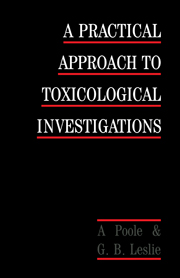Book contents
- Frontmatter
- Contents
- Foreword
- Preface
- List of abbreviations
- 1 Introduction
- 2 Regulatory requirements
- 3 Animals: sources, selection, husbandry
- 4 Standard studies in animals
- 5 Measurements and observations made in living animals
- 6 Terminal studies
- 7 Specialised routes of exposure
- 8 Reproductive toxicology
- 9 Genotoxicity
- Appendix 1 Toxicology data requirements for clinical trial approval and registration of new drugs
- Appendix 2 Countries and addresses of regulatory agencies
- Index
9 - Genotoxicity
Published online by Cambridge University Press: 04 August 2010
- Frontmatter
- Contents
- Foreword
- Preface
- List of abbreviations
- 1 Introduction
- 2 Regulatory requirements
- 3 Animals: sources, selection, husbandry
- 4 Standard studies in animals
- 5 Measurements and observations made in living animals
- 6 Terminal studies
- 7 Specialised routes of exposure
- 8 Reproductive toxicology
- 9 Genotoxicity
- Appendix 1 Toxicology data requirements for clinical trial approval and registration of new drugs
- Appendix 2 Countries and addresses of regulatory agencies
- Index
Summary
The purpose of this chapter is to introduce the reader to genotoxicity (mutagenicity) testing, provide a description of the major test systems currently in use, speculate on future developments and describe the regulatory requirements associated with this area of toxicology. It is not, however, possible to cover this topic without examining some of the reasons why genetic toxicology has, in a relatively short period of time, achieved such apparent importance and why, in comparison to other branches of toxicology, it generates such varied and extreme opinions.
Before considering the role of genetic toxicology in the pharmaceutical industry, it is important to understand the rationale for undertaking such studies and the reason why such importance is attributed to them. Genotoxicity testing is based upon the knowledge that various agents, collectively known as mutagens, possess the ability to interact with and damage DNA. Such DNA damage occurring in somatic cells may result in tumour development, while abnormal offspring could result from affected germ cells. The obvious requirement, therefore, is to prevent individuals from being exposed to genotoxic agents, i.e. chemicals which may not only produce mutations per se, but also have other effects on the genetic material. Thus, over the past 15 years or so, much effort has been expended in developing test systems that can be used to detect chemicals which possess the specialised property of interacting with and altering the hereditary component of living cells.
- Type
- Chapter
- Information
- A Practical Approach to Toxicological Investigations , pp. 136 - 156Publisher: Cambridge University PressPrint publication year: 1989



